Malcolm Barnes. Practical Variable Speed Drives and Power Electronics
Подождите немного. Документ загружается.

Control systems for AC variable speed drives 159
(IGBT & BJT), source (MOSFET) or cathode (GTO) terminals connected to the output
phases to the motor. This terminal is the reference terminal for the driver stage, while the
base or gate terminal must be driven
positive to turn on
or
negative to turn off
. The
power supply reference point for each of these three devices is at a different potential,
therefore requiring isolation.
The three power electronic switches connected to the negative terminal of the DC link
all
have their emitter, source or cathode terminals connected to the negative bus, and so a
single power supply could be used for all three device driver circuits, hence the minimum
of 4 isolated power supplies shown in the table. However, it is more common to use 6
identical power supplies to operate the device driver stages, as there are benefits in terms
of modularity and commonality of wiring.
There are two main methods for deriving these device driver power supplies. The first
is to provide the six isolated supplies from either a mains frequency transformer or a
SMPS, in the same way all other control power is produced. An alternative is to provide a
single high frequency square wave supply, which is coupled directly into the six driver
circuits through dedicated high frequency (usually toroidal) transformers that are part of
each driver circuit. Separate rectifier and regulation circuits then provide the necessary
plus and minus supplies for each driver stage.
The cooling fans for the converter heat-sinks can be powered from the SMPS or
directly from the mains, whichever is a cheaper solution. The major drawback of the
mains supply is the inability to deal with the different mains voltages and frequencies
which are found throughout the world. This can usually be solved by supplying the fan
through an auxiliary transformer with several primary connections to match the most
common voltage options.
:NK*)H[YINGXMOTMIUTZXURY_YZKS
A modern PWM-type AC drive operates with a fixed voltage DC bus. The fixed DC bus
voltage is normally obtained from via a 6-pulse diode rectifier bridge from a 3-phase
power supply. This voltage is usually 415 volts, 3-phase, 50 Hz while in some countries,
the voltage is 380 volts, 3-phase, 50 Hz.
When the mains power is first connected to the input terminals of the AC drive, very
high inrush currents would occur as the bank of filter capacitors across the DC bus
charge. While the diodes in the rectifier module and the capacitors may be able to
withstand these high currents, it is quite possible that upstream fuses or circuit breakers
would operate to trip out the VSD. Therefore, some provision needs to be made to limit
this inrush current. The DC bus pre-charge circuit is normally provided for this purpose.
There are two main approaches to solving the problem of inrush current:
• Pre-charge resistors, with a bypass contactor, either on AC side or DC side of
the AC/DC rectifier bridge
• The AC/DC rectifier can be a controlled rectifier bridge instead of an
uncontrolled diode bridge
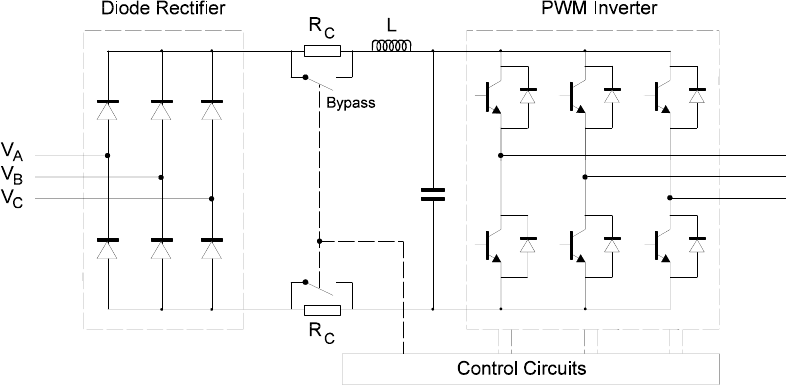
160 Practical Variable Speed Drives and Power Electronics
Figure 6.3:
Example of a DC bus pre-charging circuit
The first method is the most common method, an example of which is shown in Figure
6.3. Charging resistors are inserted between the input supply and the capacitor bank to
limit the current when power is first applied. Once the capacitors are charged, these
resistors would introduce additional losses in the VSD and therefore need to be bypassed
during normal operation. A relay (small VSDs) or contactor (large VSDs) is used to
bypass the charging resistors and carry the full rated current of the drive.
The control of the relay may be either via a simple timer circuit with a fixed time delay
between power being applied and the inverter stage being enabled. A better method is to
monitor the DC bus voltage and the bypass relay is closed after a certain voltage level has
been attained. In the better quality VSDs, feedback may be provided from each of the
power supplies in the central controller to verify their status.
Some form of interlock needs to be provided to ensure that the relay is closed before
allowing the inverter stage to operate. If not, the high load current through the VSD will
heat up and burn out the charging resistors. In addition, it is critical that all power
supplies have had the opportunity to stabilize and establish regulation. As a result, most
VSDs have a start-up lock-out circuit that delays starting for a short period after the VSD
is powered up.
There are many variations on this theme, for example the resistors and relay can be
either in the DC link or the 3-phase supply lines. There may be a single set of large
resistors and one large relay or there may be multiple sets of smaller resistors and relays.
Other variations of this technique include the use of semi-conductor bypass switches.
The main advantages of this method are:
• Simplicity of the control circuit
• Cheap and easy to implement
The main disadvantages of this method are:
• The losses associated with the relay contacts and coils
• The physical size of these components
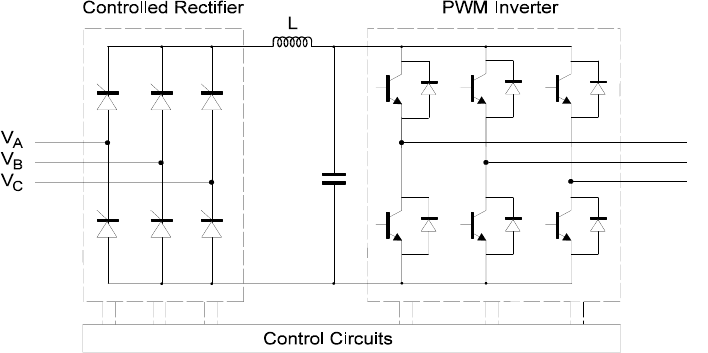
Control systems for AC variable speed drives 161
• The reliability of these electromechanical devices, particularly when the
motor control system requires a high number of energization and de-
energizations
The second, less common, approach is to replace the normal diode rectifier with a
phase-controlled rectifier bridge. This allows the capacitor voltage to be increased
gradually, by controlling the firing angle, and thereby controlling the inrush current. This
method is most often used on VSDs with larger power ratings above about 22 kW.
The main advantages of this method are:
• Conduction losses are lower
• Physical size is reduced by not having the relay
The main disadvantages of this method are:
• Power thyristors are more expensive than power diodes
• The control circuit is more complex in comparison with the relay circuit
• There is potential for false triggering of the phase control circuit due to
notching and other disturbances on the mains
• Overall reactive power requirements are slightly higher
Figure 6.4:
DC bus charging using a phase-controlled thyristor bridge
:NK6=3XKIZOLOKXLUX')IUT\KXZKXY
A conventional AC VVVF converter is made up of 5 main sub-assemblies:
•
Ac/DC converter
, usually comprising a diode rectifier, for converting the 3-
phase AC voltage to a DC voltage of constant amplitude. In some cases a
phase-controlled thyristor bridge is used for DC bus charging. Once full DC
voltage is achieved, the thyristor bridge is controlled to behave as a diode
bridge.
•
The DC link
, usually comprising a DC choke, DC capacitor and a DC bus,
for maintaining a smooth fixed DC voltage for the inverter stage.
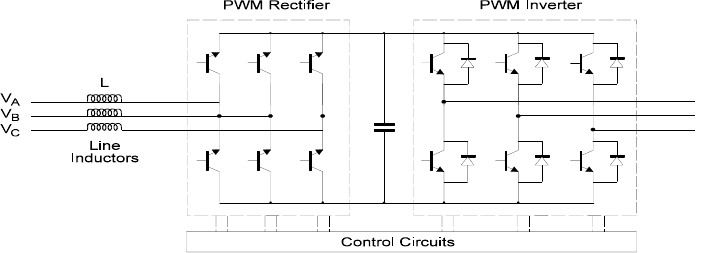
162 Practical Variable Speed Drives and Power Electronics
•
The DC/AC inverter
, comprising a semiconductor bridge, for converting the
DC voltage to a variable frequency variable voltage AC output.
• The
power supply modules
, for providing power to the control circuits for
the interface system and the inverter switches.
• The
digital control system
, comprising the sequence control, internal control
loops, protection circuits and user interfaces.
The
AC/DC rectifier
at the front end of the converter supplies the DC bus and
capacitor with voltage from the AC mains supply. Using a 6-pulse diode bridge rectifier
for this purpose has two main disadvantages:
• The AC line current waveform is non-sinusoidal (refer to Chapter 4) and is
the source of odd harmonics, such as the 5th, 7th, 11th, 13th, etc. This high
level of interference can couple to other equipment and disturb their normal
operation.
• The harmonic current distortion results in a distortion of the voltage at the
point of common coupling (PCC) which, if high enough (large VS drives),
can affect the performance of other electrical equipment connected to the
power supply system.
• Full four-quadrant operation is difficult with the diode rectifier because
electrical power can only be transferred in one direction (refer to Chapter 3),
which makes regenerative braking impractical with a standard AC VVVF
drive.
If a PWM-type controlled rectifier (also called an ‘active front end’) were used, it could
provide a solution to many of these problems. The 6-pulse PWM bridge converter with
IGBTs is shown in Figure 6.5 and is electrically similar to a normal PWM inverter. As
with the PWM inverter, it can transfer electrical energy in either direction, depending on
the switching sequence of the IGBTs. For correct operation, it requires some minimum
value of inductance in the line to avoid damage to the power semiconductor devices
during switching. Line chokes may need to be added if the supply has a high fault level
(low source impedance).
Figure 6.5:
The PWM rectifier for AC converters
One of the main problems of AC to DC power conversion using thyristor bridges, is the
poor displacement factor due to phase-shifting of the current relative to the voltage and a
bad power factor due to the distortion of the AC current waveform, which is non-
sinusoidal. The PWM converter is capable of correcting both of these problems by
drawing nearly sinusoidal current from the mains at unity displacement factor.
Control systems for AC variable speed drives 163
The unity displacement factor is achieved by forcing the current waveforms to exactly
follow the fundamental voltage waveform at fundamental frequency, usually 50 Hz. The
in-phase component of current is controlled to maintain the capacitor voltage at a required
level, while the out-of phase (quadrature) component of current can be made to be zero or
leading to give a degree of power-factor correction for other loads.
Using pulse width modulation techniques, the current waveform can be made to be
relatively undistorted (sinusoidal) and the reactive power requirement due to distortion
will also be eliminated. This is assisted by the filtering effect of the line inductance.
<GXOGHRKYVKKJJXO\KIUTZXURRUUVY
An AC frequency converter is designed to control both the voltage and frequency fed to
the motor and is therefore often called a variable voltage variable frequency (VVVF)
controller. The digital control system automates this process. For example, when an
operator selects a speed setting on a potentiometer, the VSD control system implements
this selection by adjusting the output frequency and voltage to ensure that the motor runs
at the set speed. The accuracy of the control system and its response to the operator's
command is determined by the type of control system used on that particular VSD.
The type of control used in VSD control systems follows an approach similar to that
used in normal
industrial process control
. The level of control can be:
•
Simple open-loop control
, no feedback from the process
•
Closed-loop control
, feedback of a process variable
•
Cascade closed-loop control
, feedback from more than one variable
5VKTRUUVIUTZXUR
The purpose of an electrical VSD is to convert the electrical energy of the mains power
supply into the mechanical energy of a load at variable speed and torque. In many
applications, VSDs are simply required to control the speed of the load, based on a
setpoint command provided by an operator or a process controller.
Conventional VVVF converters are voltage source devices, which control the
magnitude and frequency of the
output voltage
. The current that flows depends on the
motor conditions and load, these are not controlled by the AC converter, but are the result
of the application of voltage. The only current control that is exercised is to limit the
current when its magnitude reaches a high level, for example at 150% of full load current.
There is no provision made for feedback of speed information from the motor to check
if it is running at the required speed or if it is running at all. If the load torque changes,
and slip increases or decreases, the converter would not adjust its output to compensate
for these changes in the process.
This method of
open-loop control
is adequate for controlling steady-state conditions
and simple applications, such as centrifugal pumps & fans or conveyors, which allow a
lot of time for speed changes from one level to another and where the consequences of
the changes in the process are not severe.
)RUYKJRUUVIUTZXUR
In industry, there are also those more difficult applications, where speed and/or torque
must be continuously and accurately controlled. The required accuracy of the control is
important and can have a large influence on the choice of drive technology. For those
drive applications that require tight dynamic control, closed-loop control is necessary.

164 Practical Variable Speed Drives and Power Electronics
This type of performance can be achieved with closed loop vector control AC drives and
standard DC drives.
Standard VVVF AC drives can be used in closed-loop control systems, such as
pumping systems, which regulate pressure or flow, but in general these applications are
not capable of high performance.
The typical configuration of a closed-loop VSD system is shown in Figure 6.6 and
consists of the following main components:
• The
motor
, whose role is to convert the electrical energy of the supply into
the mechanical energy necessary to affect the load
• A
transducer for measuring
the load quantity, which is to be controlled.
This is used as a feedback signal to the control system. Where
speed
is
important, the transducer can be a tachometer (analog system) or an encoder
(digital system).
Where position is important, the transducer is a resolver (analog system) or an absolute
encoder (digital system). However, there are less expensive means for measuring speed
and position, depending on the required accuracy. Where current is important, the
transducer is a current transformer.
• A
converter
which controls the flow of electric power to the motor. This is
achieved with a power electronic converter, involving solid-state devices
switching at high frequency under the control of a digital circuit.
• A
controller
, which compares the desired value of speed or position, called
the set-point (SP), with the measured value, called the process variable (PV)
and then gives a
control output
which adjusts the speed and torque to reduce
the error (SP–PV) to zero. Previously, controllers were implemented by
analog circuits, using operational amplifiers (Op-Amps). Modern controllers
are implemented using microprocessors and digital circuits.
Figure 6.6:
Schematic of a closed-loop VSD control system
The desired value of the load, such as the speed, can be set manually by an operator
turning a potentiometer (analog system) or by dialing up a value on a keypad (digital
system). If the VSD is part of a complex control system, the desired value can be passed
down from the process control system (PLC or DCS), either by means of a 4–20 mA
signal (analog system) or by means of a serial data link (digital system).
If each quantity in the control loop was directly proportional to the quantity before it,
simple open-loop control of speed would be adequate, without the need for feedback of
the process variable (PV). In AC drives, if accurate speed control is required, then
feedback of the torque and speed variables is necessary. In particular, the motor current
responds to an increase in motor frequency with a rise time dependent on its leakage
inductance. On the other hand, the motor speed follows the torque with a rise time

Control systems for AC variable speed drives 165
dependent on its inertia. While these inaccuracies may be acceptable in simple
applications, such as pump speed control, it may not be acceptable for other difficult
applications, such as the variable speed drives in a paper machine, where several drives
operate in tandem. In these difficult applications, improved performance can be obtained
with the use of several closed-loop control systems working together, known as multi-
loop or cascade control.
This type of
closed-loop control system
has been redrawn in Figure 6.7 to emphasize
the most important control aspects. The term closed-loop feedback control emphasizes
the nature of the control system, where feedback is provided from the output back to the
input of the controller.
Figure 6.7:
A closed-loop feedback control system
In a closed-loop variable speed drive, the following takes place:
• Measurement of the process variable using an encoder
• Comparison of the process variable (measured speed) with the set point
(desired speed) to give an error signal. SP – PV = error signal
• This error signal is then processed by the controller to adjust the output signal
to the process, in this case, the AC converter, motor and speed transducer.
Figure 6.7 could be misleading because, in practice, the error point is usually part of the
controller
)GYIGJKJIRUYKJRUUVIUTZXUR
For the difficult applications, which require very close speed and torque control, with a
fast response to changes in the process, a single-loop controller may not be adequate to
anticipate all the delays in the process. These make the controller difficult to design and
difficult to setup during commissioning. Fortunately, a technique that deals with the
problem in several smaller steps has evolved from past experience with DC drives. The
solution consists of two cascaded closed-loop controllers. The basic setpoint is the speed
setpoint, which is set by an operator via a potentiometer or from a PLC. Rather than
attempting to calculate the desired inverter frequency directly to meet these speed
requirements, a DC drive achieves this in two stages.
• The first
speed control loop
uses the speed error to calculate the desired
torque setpoint to either increase speed (accelerate) or decrease speed
(decelerate). The
speed control loop
only has to allow for one of the time
delays in the system, which is the delay between the torque and the measured
speed. This compensates for the mechanical transients in the system, mainly
load inertia.
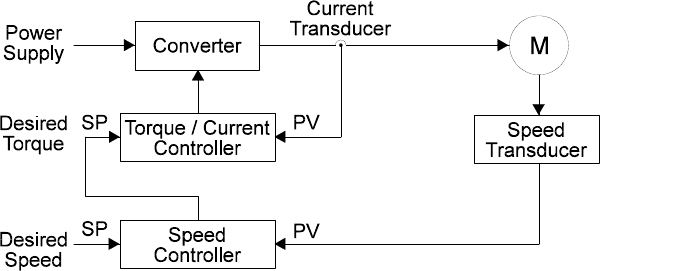
166 Practical Variable Speed Drives and Power Electronics
• The second
torque control loop
compares this set torque, the output of the
speed controller, with the actual measured value and calculates the desired
output frequency. The measured process variable in this case is the measured
motor current, which is proportional to the motor torque. Therefore, this
control loop is often called the current loop.
A vector control drive uses a similar strategy. In the design of the torque control loop, it
is assumed that the rate of change of current is much faster than the rate of change of
speed. This is equivalent to assuming that the motor is running at a constant speed.
Consequently, the current loop only has to allow for the time delay between the output
frequency and the current. As well as giving the desired inverter output frequency, it also
gives the desired inverter voltage since the two are related. Both quantities are passed to
the PWM switching logic, which controls the inverter switching sequence and speeds (see
Figure 6.8).
The
current control loop
compensates for the electrical transients, mainly the winding
inductance and resistance.
The block diagram of the cascaded loop controller comprises:
• An outer (major) speed control loop
• An inner (minor) torque control loop
Figure 6.8:
Cascade controller for speed and torque
A major advantage of the cascaded controller is that it is possible to impose a current
limit on the drive output by placing a limit on the input to the current/torque loop. This is
usually set to prevent the speed control loop from asking for any more than about 150%
of rated current from the current loop.
The current loop can respond quickly, in less than 10 ms. The speed loop responds
more slowly because motor and load inertia are usually substantial. A response time of
about 100 ms is typical for the speed control loop.
The response of the amplifier for the speed or current controller to a step change is
shown in Figure 6.9. The simplest type of controller amplifier is one whose output is
proportional to the input, called a proportional amplifier or P-control. P-control is not
used in speed and current control loops because it does not respond well to the
requirements for high accuracy and a fast dynamic response. It is more common in high
performance VSDs to use proportional-integral control, or PI-control. The step response
for PI-control consists of a combination of the step output of the P-control and a ramp due
to the integral control.

Control systems for AC variable speed drives 167
Figure 6.9:
Response of P and PI controllers to a step input
(a) Step input control change
(b) Proportional controller output
(c) Proportional/Integral controller output
<KIZUXIUTZXURLUX')JXO\KY
The term vector control is probably one of the more abused terms in industrial control
and consequently has caused considerable confusion amongst users of VS drives. Vector
control for AC variable speed drives has been available from some drive manufacturers
since the mid-1980s. The technique of vector control has only become possible as a result
of the large strides made in solid-state electronics, both with microprocessors and power
electronics.
It has been promoted as an AC drive equivalent to DC drives and claimed to be suitable
for even the most demanding drive applications and this is where the confusion arises.
The statement is true, but only to the extent that the principles of vector control are
implemented. There are degrees to which this enhanced type of control can be applied to
AC variable speed drives. Some manufacturers have encouraged this confusion in an
effort to attribute higher performance characteristics to products that only partially apply
the technology of vector control. The meaning of the various terms is covered later in this
chapter after the fundamental principles of vector control are explained. Today, the term
‘vector control’ has become a generic name applied to all drives which provide a higher
level of performance (compared to the fixed V/f drives).
Referring back to Chapter 2, electric motors produce torque as the result of the
interaction of two magnetic fields, one in the fixed part (stator) and the other in the
rotating part (rotor/armature) and their interaction across the air-gap. The magnetic fields
are produced by the current flowing in the windings of the stator and rotor. The motor
torque depends on the strength of both of these magnetic fields. In fact, torque is
proportional to the product of the currents producing these two magnetic fields.
In a DC drive, it is fairly well understood that the output torque is proportional to the
product of two current vectors, the armature current I
a
(torque producing current) and the
field current I
f
(flux producing current), at 90
o
to one another. In practice, the field current
(flux producing current) is normally held constant. Consequently, the armature current Ia
is directly proportional to output torque of the motor. Armature current (I
a
) can be used as
the torque feedback in the cascaded closed-loop controller. Both these currents can
readily be measured and accounts for the simple control of the DC drive.
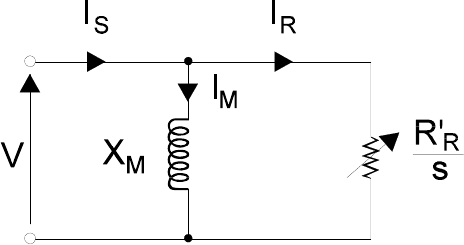
168 Practical Variable Speed Drives and Power Electronics
In an AC induction motor (refer to equivalent circuit in Figures 2.5, 2.6 and 6.10), the
flux producing current (I
m
) and torque producing current (I
r
) are ‘inside’ the motor and
cannot be measured externally or controlled separately. As in the DC drive, these two
currents are also roughly at 90
o
to one another and their vector sum makes up the
stator
current
, which can be measured (Figure 6.11). This is what makes the vector control of
an AC motor more difficult than its DC counterpart. The challenge for the AC flux-vector
drive is to distinguish and control these two current vectors without the benefit of two
separate circuits and only being able to measure and control the stator current.
The strategy of an AC vector control drive is to
calculate the individual current
vectors
to eventually enable separate control of the flux current and/or the torque current
under all speed & load conditions. As in the DC drive, the aim is to maintain a constant
flux current in the motor.
The calculation of the current vectors involves the measurement of the available
variables (such as the stator current (I
s
), stator voltage (V
s
), phase relationship, frequency,
shaft speed, etc) and applying them to a ‘motor model’, which includes the motor
constants (such as the stator resistance & inductance, the rotor resistance & inductance,
the magnetizing inductance, number of poles, etc). Because of the many variables, there
are many possible applications of a motor model, from simple estimation of motor
conditions to those that are very comprehensive and very accurate. The more detailed the
motor model, the more processing power is required.
Figure 6.10:
Simplified equivalent circuit of an AC induction motor
Under
motor no-load conditions
, almost all the no-load stator current I
S
comprises the
magnetizing current. Any torque-producing current is only required to overcome the
windage and friction losses in the motor. Slip is almost zero, stator current lags the
voltage by 90
o
, so power factor is close to zero (Cosφ = 0).
At
low motor loads
, the stator current I
S
is the
vector sum
of the magnetizing current
I
M
(unchanged), with a slightly increased active torque-producing current. Stator current
lags the voltage by a large angle φ, so power factor is poor (Cosφ << 1). Slip is still small.
At
high motor loads
, the stator current I
S
is the
vector sum
of the magnetizing current
I
M
(unchanged), with a greatly increased active torque-producing current, which increases
in proportion to the increase in load torque. Stator current lags the voltage by the angle φ,
so power factor has improved to be close to the full load power factor (Cosφ = 0.85).
